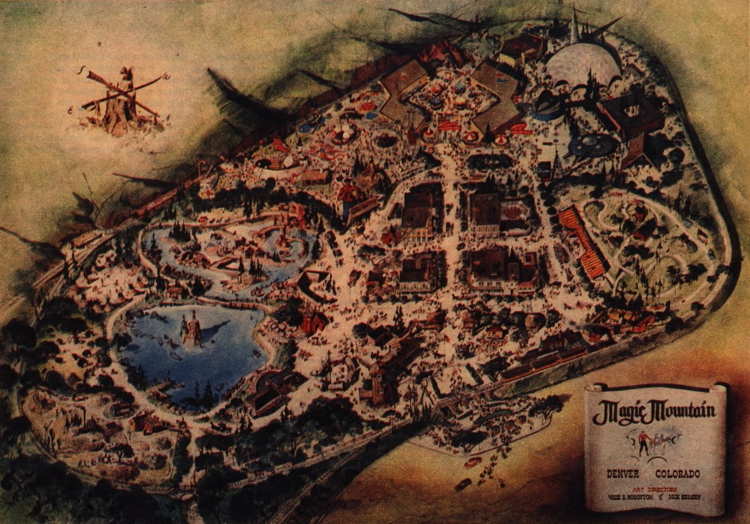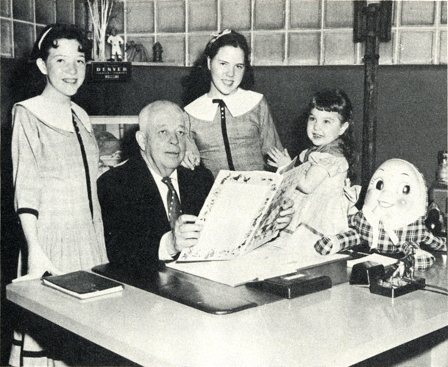
A noted author once said, "Give me men to match these mountains."
In 1952, noted Wheat Ridge businessman Walter Francis Cobb, Denver sculptor John Calvin
Sutton, and Wheat Ridge broker Charles Louis Wendt dreamed up the idea of a new, fun, family resort for the Denver area,
called Magic Mountain. Their vision: to build an entertaining, recreational
and educational theme park for the people of the Denver area and beyond to enjoy.
Its visionaries certainly were capable gentlemen. Cobb, a native of Denver,
was a graduate of Regis College and a Navy veteran of World War I. He
went into the plumbing and heating contracting business in 1930, eventually
becoming a successful self-made developer. Sutton was born in Nebraska
and came to Pueblo in 1920, and learned the sculpture arts. An accomplished
wood carver, Sutton headed the art department of the Paradice Decorating Company. Wendt, a sales executive and broker, was an officer and director of the Hathaway Investment Corporation that could underwrite stock offerings. Wendt thought of making it a theme park type concept, and Cobb and Sutton took the reins to become its founding fathers.
Meanwhile, in Los Angeles, Cornelius Vanderbilt Wood Jr. spent 2 years researching the economic feasibility of building another such theme park, for a person well-known to the world as Walt Disney. Disney liked what he saw, and decided to build it. He hired C.V. Wood to serve as Vice President and General Manager to help create a 62-acre, $16 million facility in Anaheim, known as Disneyland. When it opened in 1955, the theme park critics said would not last proved a huge success. After 6 months of managing Disneyland, Wood quit the park and decided to go into the theme park creation business himself. As the Wall Street Journal put it: "His idea: Take the Disney concept of a family-type amusement park devoid of thrill rides and small hucksters of the hot-dog-and-soda-pop variety, and plant such parks at the doorsteps of other communities." The young executive hired over a dozen of Walt Disney's former staff and created a new theme park development firm, Marco Engineering Co., Inc., based in Los Angeles. The company, which managed enterprises as diverse as soil conditioners and a diamond mine in Venezuela, offered aspiring entrepreneurs a complete 15-man package of theme park-creating talent. Meanwhile, in May of 1957, Magic Mountain Inc. was organized, selling stock to people interested in making this theme park a reality. Cobb chose the northeast alcove of South Table Mountain just east Golden for the park's location, purchasing 220 acres with an option for 240 more, gaining the necessary building permits and pouring the first foundation. Controversy unexpectedly erupted over this South Table Magic Mountain proposal, so while Magic Mountain had the rights to build there, Cobb and the company chose instead to walk away, and to a new, and better location. This place was Apex Gulch just southwest of Golden. This was the historic locale of the frontier gold rush town of Apex, which existed here from 1861 into the 1870s. The tented portion of the village, its wagon road, and the toll house of Wilbourn D. Amos had traversed Magic Mountain's property. Jackson Hill, which the road originally went straight up the slope of, overlooked the site, and had itself been a landmark on the way to the gold fields. Thinking over over the park's plans, Cobb's attention was quickly grabbed by Marco and all that its talented people had to offer Magic Mountain. Cobb brought Marco on board, and they brought their team to Denver and got to work, quickly enhancing the concept into an impressive Disney-type theme park featuring area architecture and history. Atop this page is the artistic layout of the original plans for Magic Mountain, as created by art directors Wade B. Rubottom and Dick Kelsey. From the parking lot patrons entered beneath the Magic Mountain Railroad trestle, through the guardian frontier Cavalry Post buildings, into the Victorian village of Centennial City. Straight down the main street at the upper end of this layout was to be the Magic Mountain Fairgrounds. To the lower right was to be the racetrack; above that, the Outer Space Lines ride and the Magic of Industry exposition area. On the lower left side was a lake surrounded by fur trappers and an American Indian village of tepees in a circle. At the upper left was Storybook Lane, entered by walking beneath the giant gateway of Paul Bunyan. |

